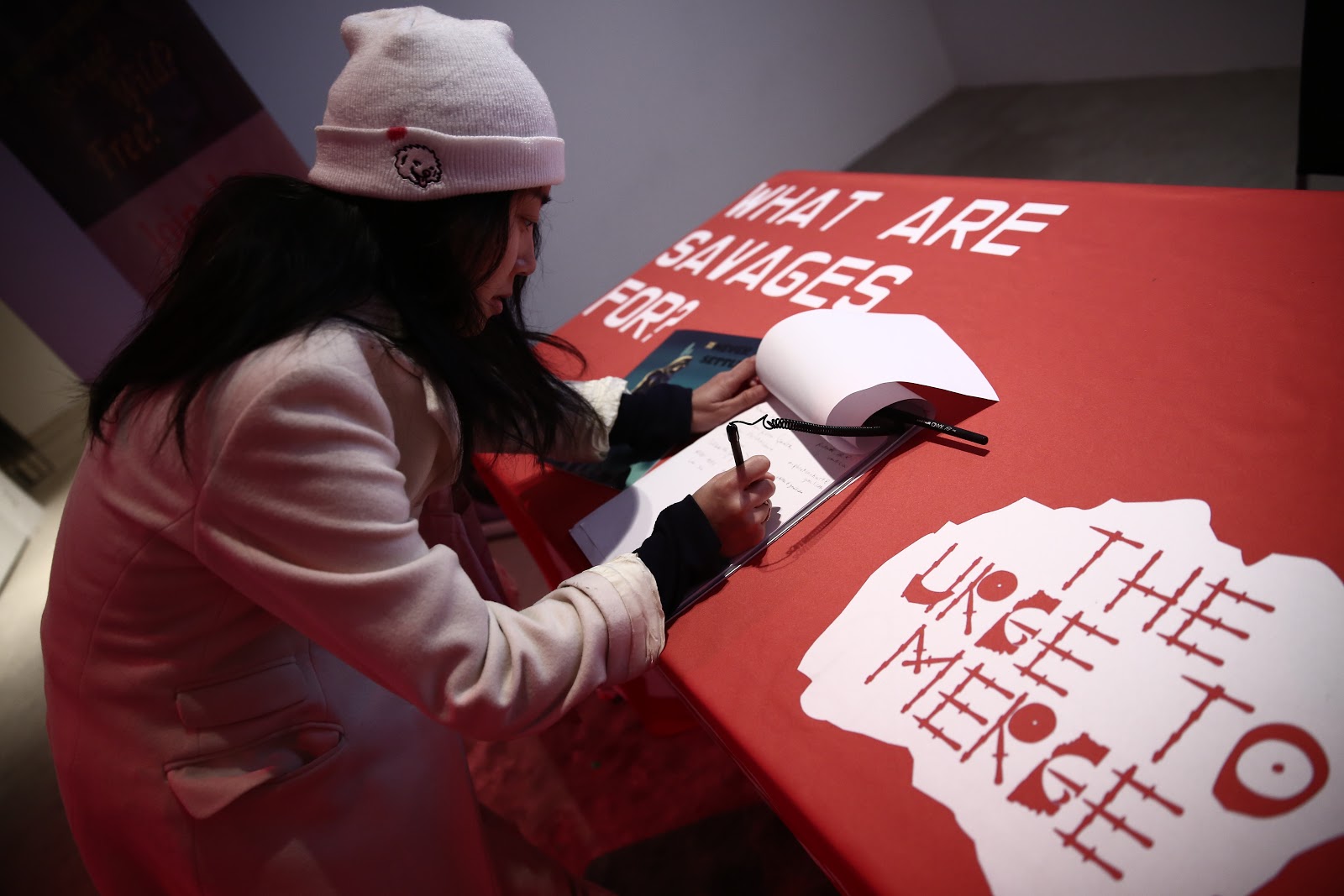As Arts and Activism Blur, “Georgia” Provides a Place for Critical Thinking

“New Red Order: Informants Get Paid!” by New Red Order, a public assembly at Artists Space, 2020. Courtesy of Artists Space, New York. Photo by Paula Court. Published in “Never Settle: A Conversation with Adam Khalil, Zack Khalil, and Jackson Polys” by Suzy Halajian, Georgia (April 30, 2020).
The boundaries between art and activism are increasingly overlapping. As artists and practitioners incorporate or borrow from historical and contemporary means of political and social organizing, these elements have become a primary feature of their work. After participating in a series of public and community-based events, Los Angeles-based writers and curators Anthony Carfello, Shoghig Halajian, and Suzy Halajian received a 2017 Andy Warhol Foundation Arts Writers Grant to support their online platform, Georgia, which publishes writing about contemporary problems. The issues range from segregation and colonial legacies to civil uprisings in the past and present, looking in particular at how these struggles are interpreted by artists and activists from both within their region—Los Angeles—and further afield.
Shiv Kotecha, Manager of Grants and Services at Arts Writers, spoke to Georgia about the many directions their blog project has taken, and what they’re working on next.
Shiv Kotecha—How would you describe Georgia, the website for which you received an Arts Writers Grant?
Georgia—Georgia is interested in the shared concerns between artistic practice and political activism, challenging the binary that often pits real activism against art activism. Our intention is to look to both artistic and organizing efforts for suggestions of a way forward, away from the complicities of cultural production and toward greater solidarity with communities in struggle.
Through a series of invitations—in the form of texts, conversations, and republished material—the writing on our online journal Georgia explores the contested sociopolitical functions of art and its larger reception. In bringing a variety of writerly forms together, we aim to emphasize the importance of multiple, shifting perspectives. Using historical case studies and informed by our many era-defining issues—among them immigration, gentrification and displacement, indigenous rights, queer histories and resistances, and arts education—the writing featured on Georgia investigates how imagery, performance, exhibition, and design have become communicative as tools that may shed light on the systematic oppression of marginalized individuals and communities.
At the heart of our journal is the claim that artistic practice is counter-hegemonic, imbued with the capacity to push against dominant ideologies and incite direct action in the name of social change. Through writing, we identify multiple entry points into these generative conflicts by way of texts that critically intertwine with current events.
Shiv—What brought you three together as collaborators on this project?
Georgia—The three of us have worked together for over five years and Shoghig Halajian and Suzy Halajian have an ongoing collaborative curatorial practice dating to 2007. In 2015, we founded invitation of sorts: a talk series, a weekly discussion in Suzy’s East Hollywood storefront apartment with invited participants including Jennifer Doyle, rafa esparza, Black Radical Imagination (Erin Christovale and Amir George), and Mimi Zieger. Different Los Angeles colleagues and friends presented on their current research, ranging from questions around access and representability in art practices to acts of resistance within institutions.
In 2016, that project expanded to include newly commissioned texts by writers such as Raquel Gutiérrez, Gelare Khoshgozaran, and others. A key stake of invitation of sorts was to offer a regular place to gather and exchange—underscoring community—and support each other’s work while exploring pressing issues within artistic production and the culture at-large. We offered dinner, too, as part of emphasizing this as a shared space.
Shiv—Has the Arts Writers Grant allowed you to expand, or enrich any of those interests?
Georgia—The three of us have worked in the arts in Los Angeles for a long time, in both institutional contexts and self-initiated projects. The Art Writers Grant gave us the means to continue a collectively-imagined structure that regularly fuels our work and allows us to initiate new collaborations. It also allows us to support our own writing and new collaborations with people who are doing important work in artistic production and community organizing. This includes individuals we already have an ongoing relationship with, along with new names and projects that we feel might provoke an engaging dialogue through the online journal format. In that way, it has been generative and challenging. At the same time, it has given us the opportunity to slowly create an archive of pressing questions, issues, and creative responses that reflect our contemporary moment and beyond.
Shiv—Can you talk about one or two articles you’re excited about lately? They can be recently published or in the works.
Georgia—We are currently editing a text by Daniela Lieja Quintanar, the curator at Los Angeles Contemporary Exhibitions who is reflecting on lessons she learned during her time at the Escuelita Zapatista in Chiapas, Mexico. The Esuelita spreads the word about “un mundo donde quepan muchos mundos” (a world where many worlds fit), as a call for disparate groups around the globe to organize and resist in collectivity. After this, we have texts by artist, activist, and scholar Latipa, artist Caitlin Berrigan, and choreographer and artist Adham Hafez. We are incredibly excited and grateful to be working with everyone who’s contributed so far.
Check out and learn more about the Georgia digital publication.
